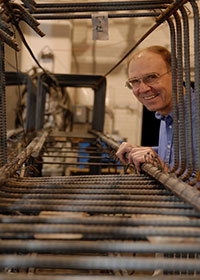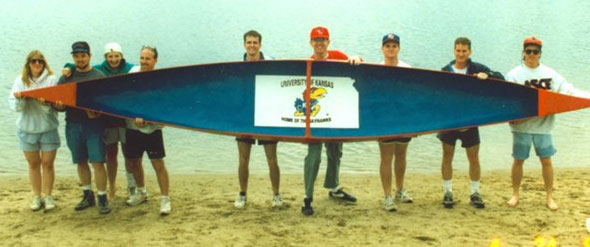An Especially Fruitful Tenure

David Darwin recently stepped down as chair of the CEAE department after 10 years on the job. As of the 15th of July, he completed 50 years at KU.
Darwin has enjoyed a particularly fruitful tenure at the University of Kansas. A former president of the American Concrete Institute and now former chair of the CEAE department, Darwin is returning to teaching courses in structural engineering materials, reinforced concrete and prestressed concrete. The research he’s best known for is in evaluating corrosion protection systems for reinforcing steel, the bond strength between steel and concrete and the reduction of cracking in concrete structures.
He was also advisor for the concrete canoe program from 1975 to 2006.
“Google concrete canoeing,” he urged. “I brought the concrete canoe competition to KU in the spring of ‘75. It’s now a national event.”
So where did such a long and storied career begin?
An Education, Courtesy of the U.S. Army

Darwin’s academic career included help from the Army. He earned one of the very first scholarships offered by the Army ROTC, which helped pay for his education at Cornell. In 1967 he graduated at the top of his class with a bachelor’s in civil engineering. He went on active duty right away, but, since he ranked at the top of his class, the Army permitted him to pursue his master’s degree, just as it did for the top 5% of West Point graduates. The National Science Foundation paid his tuition, the Army paid his salary and he earned a master’s in structural engineering in 14 months.
Then he went on “real” active duty for the next four years. After rigorous training in the elite Airborne and Ranger schools, he joined the 82nd Airborne in 1969 and shipped off for Vietnam in January 1970.
“In Vietnam, I was with three different battalions, but they all were all involved in construction,” Darwin said. “Other than being in a kind of dangerous area and being away from my family, it was a very positive experience.”
He returned home on Christmas Day, 1970. His new assignment: to take the Engineer Officer Advanced Course at the Army Corps of Engineers School at Fort Belvoir. Darwin had misgivings, because taking this course would lock him into an additional two-year tour in the Army.
He showed up, only to find that his session of the course had been canceled. “Can I go someplace else?” he asked, but the Army said, “No, you’re already signed in, we paid for your travel, you can’t move!” So Darwin went looking for a job on post.
Fortunately, one of his battalion commanders from Vietnam, Colonel Donald Ramsey, was the head of the Construction Engineering Division of the school, and immediately assigned him to teach in the Concrete Subsection of the Pavement and Materials Section. “Hey, concrete was what I did my master’s in,” Darwin said. “It’s perfect.”
For the next 20 months, Darwin taught concrete to engineering personnel, from enlisted men to captains.
He learned how to teach through an instructor training course developed at West Point. “This is the Army method of teaching,” Darwin said. “It’s how to stand up in front of a group. It’s how to engage, it’s how to prepare your lesson plans. After a time, I thought, ‘I’d like to do this for a living.’”
So he resigned from active duty, though he stayed in the Reserves and eventually retired as a lieutenant colonel. As he finished his doctorate in civil engineering at the University of Illinois at Urbana-Champaign in 22 months, “which is on the fast side,” Darwin started looking for a job in the spring of his second year.
Laying the Foundation for KU Structural Research
After looking at a couple of other universities, Darwin picked KU because it wasn’t in a big city, and he really liked the faculty.
At the time, Stan Rolfe worked in the field of fracture mechanics, but the civil engineering department was small and didn’t do much other research in structural engineering. Darwin is pleased that the department has added many more active researchers over the years, but in those early days, he had full run of the structure engineering lab. “It was all mine. A super-great lab, 4,000 square feet – and I had the whole thing to myself.”
So he went to work.
Though he was “pretty naïve” when he started out, he was always driven by curiosity and a need to branch out into new areas. With the support of the department and the University, he began building a research program. “If you’re building a research program, the challenge is to know what areas require study. You need to know important problems that need to be solved. And then you need to get the funding to support that research.”
At first Darwin worked dual tracks in concrete materials and reinforced concrete. Then he was approached by professors at K-State who wanted to do experimental work on composite beams — that is, beams with a concrete deck supported by steel girders. “That was not my area, but I said, sure, and we started working.” Then, funded by the National Science Foundation (NSF), he began working on a study dealing with earthquake design, an area that had always interested him.
To investigate microscopic and sub-microscopic behavior of materials under load, an area that started with his master’s work, Darwin secured funding from the NSF and the Air Force Office of Scientific Research (AFOSR). To do this research, they had to keep running over to the Ritchie Biosciences Center to use the “biologists’ SEM.” He obtained AFOSR funding to purchase a scanning electron microscope for the Engineering department to dedicate to that study.
In the late 1980s, at the behest of Dean of Engineering Carl Locke, a chemical engineer, Darwin and colleague Steve McCabe began researching the corrosion of reinforcing steel. “Nobody in the Department of Chemical and Petroleum Engineering wanted to work on that!” Darwin laughed. Their Corrosion Lab has been busy ever since. Over the years, Darwin has also overseen the Concrete Lab and many others.
“So I have many tracks to keep going,” he said. “We do lots of different things, and it’s been successful. It’s fun to do all this different research.”
So how on earth does he keep up with all of it?
It’s not easy, Darwin admits. When he was department chair, it was even harder. “I have to hand it to the other professors who work with me – my co-principal investigators – because they really kept the projects on track.”
New Inroads into Bridge Research

In the early 1990s, the Kansas Department of Transportation asked for his help to minimize cracking on steel-concrete composite bridge decks. Cracks in the concrete allow salt to trickle down and corrode the reinforcing steel, shortening the life of the bridge. KU and KDOT went in together on the research, and Darwin began evaluating the effects of design, concrete material selection, and construction methods on cracking.
After finishing two studies over eight years, he and the state bridge engineer agreed, “We know what we need to do to minimize that cracking. What do you say we actually build some of these bridges?” And that’s just what they did!
This became one of their longest-running research projects, a two-phase pooled fund study totaling 2.5 million dollars over 13 years, which involved 19 state departments of transportation and the Federal Highway Administration.
Darwin, his co-investigator JoAnn Browning, and their graduate students worked in the lab on various aspects of concrete and corrosion, used test data from bridge projects to develop improved prediction models, and put those methods to work in the field on the bridge decks as they were being constructed. Then they surveyed the results.
At the same time, they were doing a parallel project on minimizing concrete cracking, in general, to add to this pool of knowledge. And the studies have continued.
Projects to minimize cracking in bridge decks have been continuously funded from the early 1990s, and will be through at least the end of 2024.
On Civil, Environmental & Architectural Engineering

The scope of work that civil engineers do is tremendous. Recently a student in mechanical engineering told him, “This is all the same kind of stuff that I learn in mechanical engineering, except we work on machine design where everything’s like this.” Darwin brought his hands together to demonstrate. “But your stuff is so big!”
Darwin warmed to the topic. “If you step out of your house, and if it’s not moving or growing, it’s civil or environmental engineering. It’s the streets. It’s the water supply. It’s the sewers that take the waste away and it’s the treatment facilities that reclaim that water. It’s the bridges. It’s the planning of the roads and their geometry so the cars can stay on without flying off. It’s the foundations underneath the buildings and the bridges. That’s all part of civil engineering and it’s the people who construct it all.
“Then architectural engineering is everything inside the building: Heating, ventilation, air conditioning. It’s plumbing, power distribution, lighting, and fire protection. It’s acoustics – the sound inside of a concert hall. It’s amazing stuff, and it’s all part of our department.”
So, what’s the favorite part of Darwin’s work?
“Now that I’m going to get back to it, I think it’s probably equal parts teaching and research,” he said. “I enjoy it. I enjoy working with the students. I couldn’t be chair, keep doing my research, and actively teach.”
But there’s an additional benefit to teaching.
“In today’s research university, you make your name based on the research, funding and products that you put out,” he said. “But professors have the closest thing to immortality because we affect people. We teach our students, and they may not realize it, but they pick up all sorts of stuff and give it to the people they work with, and if some of them become professors they pass that on. So everything we do in a university and with our research students has an impact several generations farther down the line.”
There’s No Place Like KU

Darwin has given lectures in Japan, Greece, England, France, Taiwan, Egypt and many other countries. In his office is an embroidery was given to him when he lectured in Vietnam in 2011, returning to the country for the first time since the war. He lectured in China in 1986 and again in 2001, right after 9/11.
But the best crew he’s worked with is the department right here at home. He is decidedly optimistic about the future of the CEAE department.
“Looking forward, I think the new department chair, Caroline Bennett, is going to do a super job,” he said. “It’s just her personality and the way she operates. The potential for this department just keeps going up. We’re getting stronger and stronger. I’m proud of the increase in our research funding and the increase in the strength of our graduate program. This bodes well for the department and the university.
“KU’s faculty here has always felt like home.”